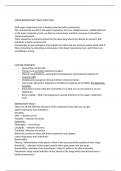Lecture notes
upper respiratory tract infection
- Institution
- Aston University, Birmingham (Aston)
LECTURE OVERVIEW • Normal flora of the URT • Primary and secondary bacterial invaders • Clinical manifestations, associated microorganisms and treatment options for common URTI • Streptococcus pyogenes (Group A Strep): virulence factors • Case study: laboratory diagnosis of streptoco...
[Show more]



